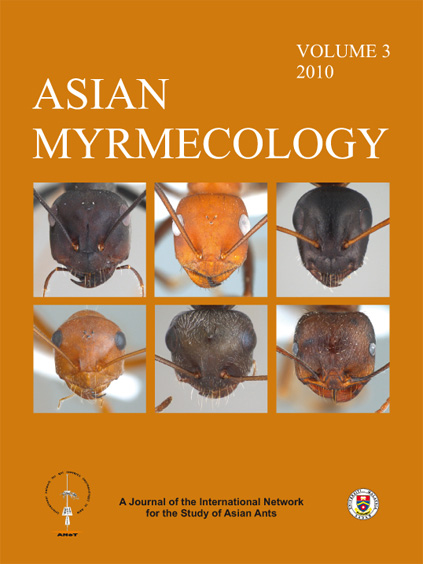ASIAN
MYRMECOLOGY
Image: François Brassard
Applied Myrmecology
Asian Myrmecology, Volume 3, pages 55-62. published April 2010
DOI: 10.20362/am.003008
Sustainable weaver ant (Oecophylla smaragdina) farming: harvest yields and effects on worker ant density
JOACHIM OFFENBERG1* & DECHA WIWATWITAYA2
Abstract:
The Asian weaver ant Oecophylla smaragdina Fabricius is renowned as an efficient biocontrol agent since it preys on a multitude of pest insects. Additionally, this ant is harvested and sold at local and international markets as a delicacy, a prized bird feed and as traditional medicine. We present the first attempt to farm this ant scientifically and test whether the harvest of ant queen brood is compatible with biocontrol, i.e., if worker ant densities are affected by harvest pressure. In a Thai mango (Mangifera indica L.) plantation, unfed ants produced fresh mass yields of 114–157 g queen brood tree-1 year -1, compared with 258–377 g for ants fed sugar and cat food. The lowest-producing treatment corresponded to a value of THB 22.8 (USD 0.65) tree-1 year-1, and the highest to THB 75.4 (USD 2.16). Worker ant densities estimated shortly after the ant harvest did not differ significantly between harvested and unharvested plots, and surprisingly the longer-term effect was a significant increase on harvested trees. We conclude that plantations can, with negligible costs, produce significant (>100 g tree-1) edible high-protein ant biomass, and that this harvest is sustainable and can be combined with ant biocontrol. Further, the yield can be increased several times through appropriate management.
Keywords:
ant husbandry, entomophagy, food ecology, food security, biocontrol, sustainable agriculture, Thailand
Get PDF (248K):
1Institute of Biological Sciences, Aarhus University, DK-8000 Aarhus C, Denmark
2Department of Forest Biology, Kasetsart University, Bangkok 10900, Thailand
*Corresponding author: rasidah@env.upm.edu.my



